Holowaty, William
Killed in Action 1945-06-18


Birth Date: 1919-May-27
Born:
Son of Fred and Mary Holowaty, of Rochester, Alberta, Canada.
Home: Rochester, Alberta
Enlistment:
Enlistment Date: Unknown
Service
RCAF
Unit
425 (TF) Sqn- Squadron
Je te plumerai I shall pluck you
Base
Rank
Flight Sergeant
Position
Flight Sergeant
Service Numbers
R/257034
Home
 Rochester, Alberta
Rochester, Alberta
First Burial
 War Cemetery At Lajes On Terceira Island, The Azores
War Cemetery At Lajes On Terceira Island, The Azores
Avro Lancaster

Canadian Warplane Heritage Museum
The Avro Lancaster is a British Second World War heavy bomber. It was designed and manufactured by Avro as a contemporary of the Handley Page Halifax, both bombers having been developed to the same specification, as well as the Short Stirling, all three aircraft being four-engined heavy bombers adopted by the Royal Air Force (RAF) during the same wartime era.
The Lancaster has its origins in the twin-engine Avro Manchester which had been developed during the late 1930s in response to the Air Ministry Specification P.13/36 for a capable medium bomber for "world-wide use". Originally developed as an evolution of the Manchester (which had proved troublesome in service and was retired in 1942), the Lancaster was designed by Roy Chadwick and powered by four Rolls-Royce Merlins and in one version, Bristol Hercules engines. It first saw service with RAF Bomber Command in 1942 and as the strategic bombing offensive over Europe gathered momentum, it was the main aircraft for the night-time bombing campaigns that followed. As increasing numbers of the type were produced, it became the principal heavy bomber used by the RAF, the Royal Canadian Air Force (RCAF) and squadrons from other Commonwealth and European countries serving within the RAF, overshadowing the Halifax and Stirling. Wikipedia
425 (TF) Sqn Je te plumerai ("Alouette")
History of the Squadron during World War II (Aircraft: Wellington III, X, Halifax III, Lancaster X)
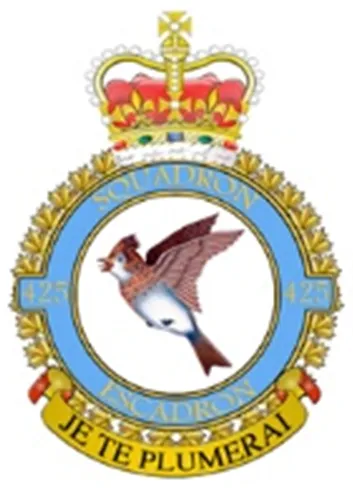
425 Squadron was formed at Dishforth, Yorkshire, UK on June 25, 1942 as the RCAF's twenty-second squadron, and fifth bomber squadron, to be formed overseas in WWII. At the time it was part of No 4 Group, RAF Bomber Command. It was unique in being designated "French-Canadian" and every effort was made to find French Canadian airmen elsewhere in Bomber Command who could be transferred to the squadron. It became operational in October, 1942, flying Wellington Mk III aircraft with the squadron code letters KW. It transferred to No 6 (RCAF) Group, Bomber Command when that was formed on January 1, 1943, although remaining at Dishforth. In March, the squadron re-equipped with Wellington X's and from June to October operated from bases in Tunisia (Kairouan/Zina and Hani East airfields) in support of the Allied invasions of Sicily and Italy. In November 1943 the squadron returned briefly to Dishforth and re-equipped with Halifax III aircraft before moving to Tholthorpe, Yorkshire in December, as part of No 62 (RCAF) Base of 6 Group. It remained at Tholthorpe until the end of the war in Europe. In May and June of 1945 it re-equipped with Lancaster X aircraft, in preparation for joining the Tiger Force for attacks on Japan. The surrender of Japan caused the disbandment of the Squadron at Debert, Nova Scotia , on September 5, 1945.
Overall, the squadron flew 328 missions, involving 3694 sorties, in the course of which 9152 tons of bombs were dropped and 55 aircraft were lost. Squadron personnel gained 2 MBE's, 63 DFC's and 4 Bars to DFC, 2 GM's, 18 DFM's, 1 DFC(USA), and 4 MiD's. Battle Honours were:English Channel and North Sea 1943-45, Baltic 1944-45, Fortress Europe 1943-44, France and Germany 1944-45, Biscay Ports 1943-44, Ruhr 1943-45, Berlin 1944, German Ports 1943-45, Normandy 1944, Rhine, Biscay 1943-44, Sicily 1943, Italy 1943, Salerno. Wikipedia, Moyes, Kostenuk and Griffin
Squadron History (Bomber Command Museum PDF)
Maps for Movements of 425 Squadron 1942-45
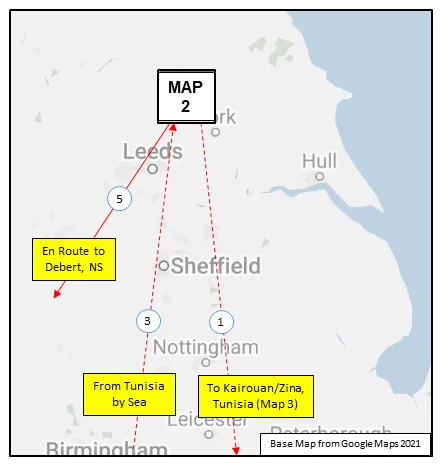 MAP 1: 425 Squadron Movements 1942-45 (right-click on image to display enlarged in new tab) |  MAP 2: 425 Squadron Movements 1942-45 (detail of Map 1) | 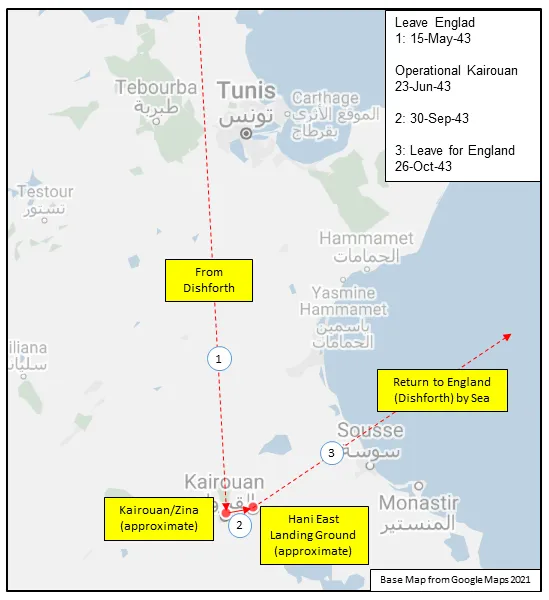 MAP 3: 425 Squadron Movements in North Africa 1943 |
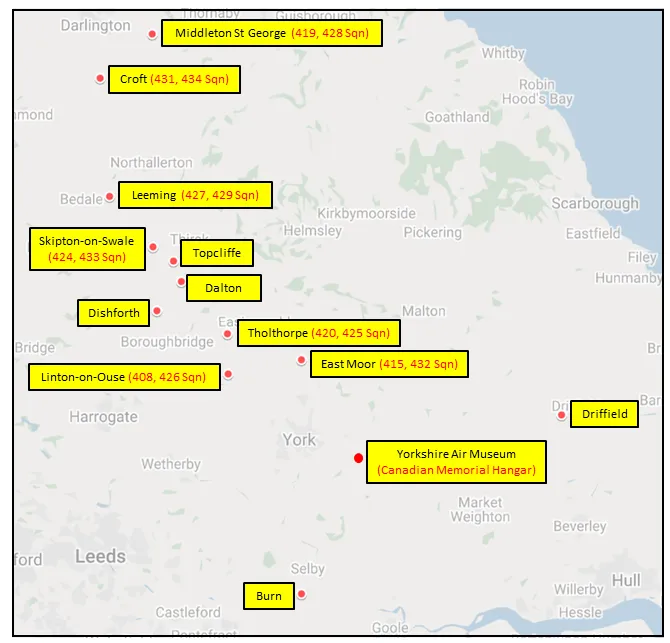
425 Squadron History Summary 1942-45
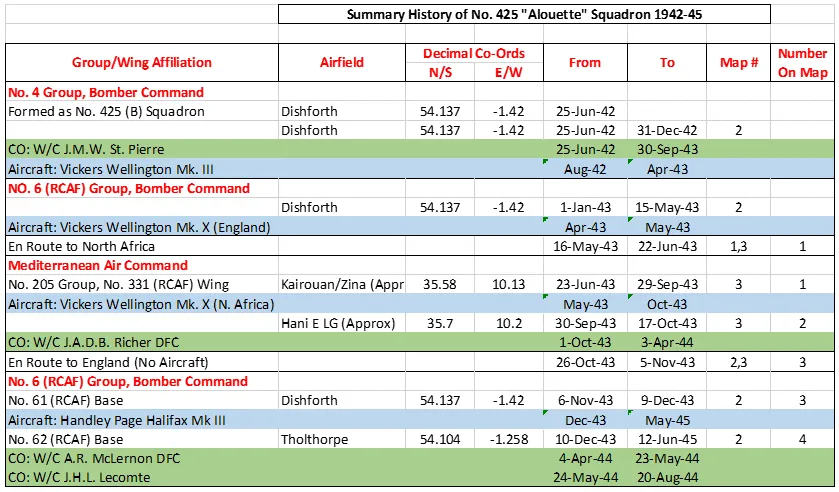
425 Squadron History Summary 1942-45 Page 2

History of the Squadron Post-WWII (Aircraft: Canuck, Voodoo, Hornet)
The squadron was re-formed as an All-Weather (Fighter) unit at St Hubert (Montreal), Quebec on 1 October 1954. It flew CF-100 Canuck aircraft on North American air defence. Selected as one of five units to be re-equipped with CF-101 (Voodoo) aircraft, it was deactivated on 1 May 1961 pending delivery of the aircraft. Reactivated at Namao (Edmonton), Alberta on 15 October 1961, the squadron initially received the trainer version of the CF-101 and served as a training unit to convert the remaining four squadrons to this aircraft. It afterwards moved to Bagotville, Quebec, in July 1962, and was declared operational on 1 October when No. 3 All-Weather (Fighter) Operational Training Unit assumed responsibility for all future CF-101 training. On 1 February 1968 the squadron was integrated into the Canadian Armed Forces. From 1982, the Canadian Forces started to acquire CF-18 Hornets; 425 Sqn received them in 1985. In 2005, 433 Squadron was merged into 425 Squadron. 425 Tactical Fighter Squadron is an integral part of NORAD and of the North Atlantic Treaty Organization (NATO). In peacetime, the squadron's fighters provide continuous surveillance of the East Coast of Canada. In addition, it must be ready for rapid deployment anywhere in the world in support of NATO or contingency operations.Wikipedia, Kostenuk & Griffin, and www.canada.ca/en/air-force/corporate/squadrons/425-squadron.html
 Canadian Virtual War Memorial
Canadian Virtual War Memorial Commonwealth War Graves Commission
Commonwealth War Graves Commission www.findagrave.com
www.findagrave.com Lancaster Bomber
Lancaster Bomber Wikipedia
Wikipedia Harold A Skaarup Web Page
Harold A Skaarup Web Page